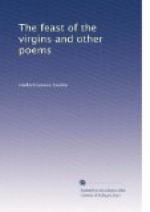That Pat hardly knew what a pickle was Pat in;
But at last it was read to the end, and the wig
Said: “Pat, are you guilty of stealing the pig?”
Pat looked very wise, though a trifle forlorn,
And he asked of milord that the witness be sworn.
“Bless yer sowl,” stammered Pat, “an’ the day ye was born!
Faith how in the divil d’ye think Oi can tell
Till Oi hear the ividince?”
Pat reckoned well;
For the witness was sworn and the facts he revealed—
How Pat stole the piggy and how the pig squealed,
Whose piggy the pig was and what he was worth,
And the slits in his ears and his tail and—so forth;
But he never once said, ’in the county of Meath,’[CX]
So Pat he escaped by the skin of his teeth.
[CX] In criminal cases it is necessary to prove that the crime was committed in the county where the venue is laid.
NOTES
[1] Called in the Dakota tongue “Hok-see-win-na-pee Wo-han-pee”—Virgins’ Dance (or Feast).
[2] One of the favorite and most exciting games of the Dakotas is ball-playing. A smooth place on the prairie, or in winter, on a frozen lake or river, is chosen. Each player has a sort of bat, called “Ta-kee-cha-pse-cha,” about thirty-two inches long, with a hoop at the lower end four or five inches in diameter, interlaced with thongs of deer-skin, forming a sort of pocket. With these bats they catch and throw the ball. Stakes are set as bounds at a considerable distance from the center on either side. Two parties are then formed and each chooses a leader or chief. The ball (Tapa) is then thrown up half way between the bounds, and the game begins, the contestants contending with their bats for the ball as it falls. When one succeeds in getting it fairly into the pocket of his bat he swings it aloft and throws it as far as he can toward the bound to which his party is working, taking care to send it if possible where some of his own side will take it up. Thus the ball is thrown and contended for till one party succeeds in casting it beyond the bounds of the opposite party. A hundred players on a side are sometimes engaged in this exciting game. Betting on the result often runs high. Moccasins, pipes, knives, hatchets, blankets, robes and guns are hung on the prize-pole. Not unfrequently horses are staked on the issue and sometimes even women. Old men and mothers are among the spectators, praising their swift-footed sons, and young wives and maidens are there to stimulate their husbands and lovers. This game is not confined to the warriors but is also a favorite amusement of the Dakota maidens, who generally play for prizes offered by the chief or warriors. (See Neill’s Hist. Minn., pp 74-5; Riggs’ Takoo Wakan, pp 44-5, and Mrs. Eastman’s Dacotah, p 55.)




